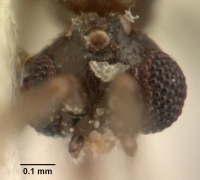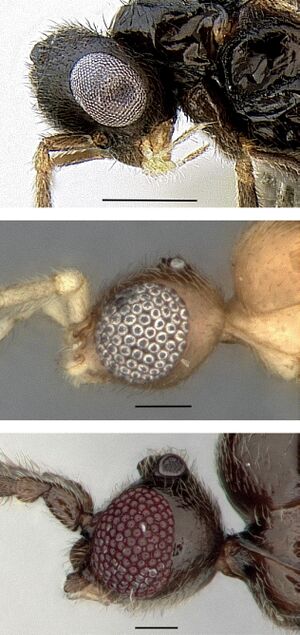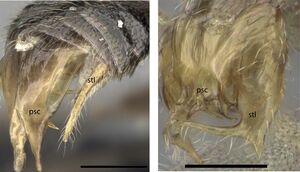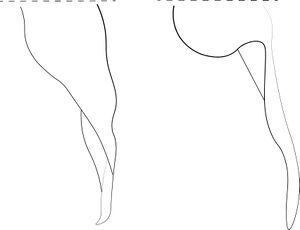Leptanilla argamani
| Leptanilla argamani | |
|---|---|

| |
| Scientific classification | |
| Kingdom: | Animalia |
| Phylum: | Arthropoda |
| Class: | Insecta |
| Order: | Hymenoptera |
| Family: | Formicidae |
| Subfamily: | Leptanillinae |
| Tribe: | Leptanillini |
| Genus: | Leptanilla |
| Species: | L. argamani |
| Binomial name | |
| Leptanilla argamani (Kugler, J., 1987) | |
The type material, all males and the only known specimens, were collected at lights and by sweeping of vegetation.
Identification
Keys including this Species
Distribution
Distribution based on Regional Taxon Lists
Palaearctic Region: Israel (type locality).
Distribution based on AntMaps
Distribution based on AntWeb specimens
Check data from AntWeb
Countries Occupied
| Number of countries occupied by this species based on AntWiki Regional Taxon Lists. In general, fewer countries occupied indicates a narrower range, while more countries indicates a more widespread species. |

|
Estimated Abundance
| Relative abundance based on number of AntMaps records per species (this species within the purple bar). Fewer records (to the left) indicates a less abundant/encountered species while more records (to the right) indicates more abundant/encountered species. |

|
Biology
Castes
Nomenclature
The following information is derived from Barry Bolton's Online Catalogue of the Ants of the World.
- argamani. Yavnella argamani Kugler, J. 1987: 53, figs. 14-18 (m.) ISRAEL.
- Combination in Leptanilla: Griebenow, 2024: 128.
Type Material
- Holotype male, Israel, Yavne, 20.X.1981 in light, inside a room.
- Paratypes, 15 males, same locality 29.VIII-5.x.1982, 3 males, same locality (but during daytime and by sweeping plants), 6.x.1982, J. Kugler; 20 males Shluchot (Jordan valley) 26.V1.1984 (by light trap).
The holotype and most paratypes are deposited in the Zoological Museum of the TAU, 2 paratypes are preserved in the The Natural History Museum, 2 in the Museum of Comparative Zoology, 1 in the Musee d'Histoire Naturelle Genève, and 1 in the collection of Dr. Q. Argaman.
Unless otherwise noted the text for the remainder of this section is reported from the publication that includes the original description.
Description
Male
Length: 1.7-2.5 mm.
Colour: Head, alitrunk, petiole, gaster and femur dark brownish-black, very shiny; antennae brown; tibiae and tarsi light brownish-yellow; genitalia yellow.
Head: Vertical, with large bulge on vertex, with eyes 1.4 times as wide as long; eyes bare, oval, very large, very convex, large diameter 0.75 times as long as head; ocelli large, anterior ocellus situated on anterior side of bulge of vertex and posterior ocelli situated on lateral sides of bulge of vertex; antennae long, scapus short less than twice as long as wide; 1st funicular segment very short, only slightly longer than wide; all other funicular segments more than 3 times as long as wide, the second the longest; clypeus convex with nearly straight anterior border; mandibles short (0.07 mm), tapering apically, anteriorly with spoon-like excavation which opens laterally at inner side near base of mandibles. Maxillae and labium short, maxillar and labial palps with 1 segment each.
Alitrunk: Two and a half times as long as greatest width. In dorsal view pronotum almost entirely covered by bulging mesonotum, scutellum triangular, separated by a furrow from scutum; basal part of propodeum dorsally concave; dorsal margin 2.5 times as long as distal descending margin.
Legs: Very long, increasing in size from fore to hind legs; fore femur straight, only 1.1 0 times thicker than mid and hind femora; fore tibia with 1 spur, mid and hind tibiae each with 2 spurs.
Petiole: Slightly longer than wide, widest at posterior margin, anteriorly with a very small stalk, posteriorly as wide as anterior margin of gaster, slightly bulging above it.
Gaster: Long, oval, slightly depressed dorsoventrally and curved; in dorsal view with 6 visible tergites, the last covering the anterior part of the genitalia,in ventral view with 5 visible stemites, last sternite covers the gonobase and subgenital plate.
Genitalia: Gonobase membraneous; subgenital plate a narrow, sclerotized, dark brown band, fused with gonobase. Gonocoxites separated dorsally and ventrally; each gonocoxite forming a leaf-like structure with not well separated gonostylus. Volsella dorsally covered by united gonapophyses, volsellar plate connected to inner base of gonocoxite, volsellar cuspis rudimental, volsellar digitus long, curved, pointed at its tip with thin, elongate, finger-like, ventral projection at base. Gonapophyses united into large shield-like, dorsally convex structure, narrowing posteriorly, separating distal of genital opening into 2 pointed lobes.
References
- Borowiec, L. 2014. Catalogue of ants of Europe, the Mediterranean Basin and adjacent regions (Hymenoptera: Formicidae). Genus (Wroclaw) 25(1-2): 1-340.
- Cantone S. 2017. Winged Ants, The Male, Dichotomous key to genera of winged male ants in the World, Behavioral ecology of mating flight (self-published).
- Griebenow, Z. 2020. Delimitation of tribes in the subfamily Leptanillinae (Hymenoptera: Formicidae), with a description of the male of Protanilla lini Terayama, 2009. Myrmecological News 30: 229-250. (doi:10.25849/MYRMECOL.NEWS_030:229).
- Griebenow, Z.H. 2021. Synonymisation of the male-based ant genus Phaulomyrma (Hymenoptera:Formicidae) with Leptanilla based upon Bayesian total-evidence phylogenetic inference. Invertebrate Systematics 35, 603–636 (doi:10.1071/is20059).
- Griebenow, Z. 2024. Systematic revision of the ant subfamily Leptanillinae (Hymenoptera, Formicidae). ZooKeys 1189, 83–184 (doi:10.3897/zookeys.1189.107506).
- Griebenow, Z.H., Isaia, M., Moradmand, M. 2022. A remarkable troglomorphic ant, Yavnella laventa sp. nov. (Hymenoptera: Formicidae: Leptanillinae), identified as the first known worker of Yavnella Kugler by phylogenomic inference. Invertebrate Systematics 36(12), 1118-1138 (doi:10.1071/is22035).
- Kugler, J. 1987 [1986]. The Leptanillinae (Hymenoptera: Formicidae) of Israel and a description of a new species from India. Isr. J. Entomol. 20: 45-57 (page 53, figs. 14-18 male described)
References based on Global Ant Biodiversity Informatics
- Borowiec L. 2014. Catalogue of ants of Europe, the Mediterranean Basin and adjacent regions (Hymenoptera: Formicidae). Genus (Wroclaw) 25(1-2): 1-340.
- Boudinot B. E. 2015. Contributions to the knowledge of Formicidae (Hymenoptera, Aculeata): a new diagnosis of the family, the first global male-based key to subfamilies, and a treatment of early branching lineages. European Journal of Taxonomy 120: 1-62.
- Kugler J. 1987. The Leptanillinae (Hymenoptera: Formicidae) of Israel and a description of a new species from India. Israel Journal of Entomology 20: 45-57.
- Vonshak M., and A. Ionescu-Hirsch. 2009. A checklist of the ants of Israel (Hymenoptera: Formicidae). Israel Journal of Entomology 39: 33-55.




